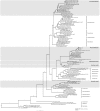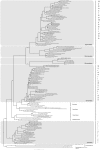The culturable mycobiota of Flabellia petiolata: First survey of marine fungi associated to a Mediterranean green alga
- PMID: 28426712
- PMCID: PMC5398637
- DOI: 10.1371/journal.pone.0175941
The culturable mycobiota of Flabellia petiolata: First survey of marine fungi associated to a Mediterranean green alga
Abstract
Algae-inhabiting marine fungi represent a taxonomically and ecologically interesting group of microorganisms still largely neglected, especially in temperate regions. The aim of this study was to isolate and to identify the culturable mycobiota associated with Flabellia petiolata, a green alga frequently retrieved in the Mediterranean basin. Twenty algal thalli were collected from two different sampling sites in the Mediterranean Sea (Elba Island, Italy). A polyphasic approach showed the presence of a relevant alga-associated mycobiota with 64 taxa identified. The fungal isolates belonged mainly to Ascomycota (61 taxa), while only three Basidiomycota were detected. The phylogenetic position of sterile mycelia and cryptic taxa, inferred on the basis of LSU partial region, highlighted the presence of putative new phylogenetic lineages within Dothideomycetes and Sordariomycetes. This work represents the first quali-quantitative analysis of the culturable mycobiota associated to a green alga in the Mediterranean Sea.
Conflict of interest statement
Figures





References
-
- Jones EBG, Pang K-L, Marine fungi and fungal-like organisms Marine and Freshwater Botany. Walter de Gruyter Berlin-Boston; 2012.
-
- Jones EBG, Are there more marine fungi to be described? Bot March 2011;54:343–54.
-
- Jones EG, Suetrong S, Sakayaroj J, Bahkali AH, Abdel-Wahab MA, Boekhout T, et al. Classification of marine Ascomycota, Basidiomycota, Blastocladiomycota and Chytridiomycota. Fungal Divers 2015;73:1–72.
MeSH terms
LinkOut - more resources
Full Text Sources
Other Literature Sources
Medical

